Safe and Efficient Polymer Electrolyte Membrane Fuel Cell Control Using Successive Linearization Based Model Predictive Control Validated on Real Vehicle Data
Abstract
1. Introduction
2. Fuel Cell Model
- The operating temperature is assumed constant at a value of 70 °C.
- The anode is operated in “dead-end” mode, no recirculation is considered in the present model setup.
- Inlet humidities are assumed to be constant.
- The effect of liquid water on the voltage is not considered.
- Cathode
- Anode
- Gas diffusion layer (GDL) on the cathode side
- Electrochemical model
2.1. Cathode Submodel
2.2. Anode Submodel
2.3. Gas Diffusion Layer Submodel
2.4. Electrochemical Model
2.5. Power and Efficiency
2.6. Overview
- Net power of the system ()
- Pressure difference across the membrane()
- System efficiency ()
3. Vehicle as Validation Data Generator
4. SLMPC Design
- Fulfill the power demand trajectory from the real vehicle shown in Figure 3a
- Safe operation
- Efficient operation
- Cathode/Anode absolute pressure—During operation, the pressures might rise or drop to a value which would, in a real setup, cause irreversible damage. If the pressure in either channel is too high, the components experience mechanical stress which can lead to fuel cell destruction. On the other hand, if the pressure is too low, starvation may occur, which is described in more detail below. Naturally, the controller must “know” that it cannot allow the system to operate outside the safe pressure range.
- Starvation—Power is mainly provided by drawing a certain amount of current from the fuel cell stack. Current is generated by the reaction of hydrogen and oxygen, the basic principle of how does a fuel cell work. The higher the current, the faster the reactants get consumed. The task of the controller becomes obvious—a sufficient amount of reactant mass must be supplied at all times. If that would not be the case, the electrons which create the current would then come from the platinum in the catalyst layer or the carbon from the gas diffusion layer. Because of starvation, the catalyst or the GDL can be consumed in a matter of seconds destroying the fuel cell [30]. In our setup, a minimum amount of oxygen/hydrogen mass is required to always be present to avoid starvation.
- Pressure difference across the membrane—Similar to the problem of absolute pressures, it is crucial to control the pressure difference between the anode and cathode at all times. Too big of a pressure difference causes stress on the membrane and if the pressure difference becomes negative i.e., the pressure on the cathode side becomes greater than on the anode side, other unfavorable effects can occur, such as pushing the water (generated on the cathode side) over to the anode.
- Purging—As there is air on the cathode side instead of pure oxygen, the effect of nitrogen which does not participate in the reaction must be taken into account. It diffuses through the membrane to the anode side, accumulating and effectively lowering the availability of hydrogen for the reaction potentially causing local starvation. If, in turn, the controller would want to keep a sufficient reserve of hydrogen, it would pump in more and more hydrogen, potentially violating the pressure restriction. Therefore, the necessity of clearing (purging) the anode of nitrogen is obvious. Purging is done by opening the purge valve for a short period of time and then closing it again to not waste hydrogen into the environment. The opening is commonly triggered by a Coulomb counting strategy.
- Compressor power—To supply the air needed for the operation, a compressor is used which uses the power generated by the fuel cell. One of the goals of the controller is to minimize the usage of the compressor which would increase system efficiency as is visible from Equation (4).
4.1. Linearization of the Nonlinear System
4.2. Discretization of the Linearized System
4.3. Control Goals
- The reference value for the power is actually the power demand acquired from the vehicle.
- The membrane pressure difference is, if possible, kept at 200 mbar.
- The efficiency is maximized, having a reference value of 1.
4.4. Constraints
4.5. SLMPC Numerical Values
5. Results and Discussion
5.1. Power Demand Tracking
5.2. Safe Operation
5.3. Efficient Operation
6. Conclusions
Author Contributions
Funding
Acknowledgments
Conflicts of Interest
References
- Barbir, F. PEM Fuel Cells: Theory and Practice, 2nd ed.; Elsevier Inc.: Amsterdam, The Netherlands, 2013. [Google Scholar]
- Pukrushpan, J.T.; Peng, H.; Stefanopoulou, A.G. Control-oriented modeling and analysis for automotive fuel cell systems. J. Dyn. Syst. Meas. Control. Trans. ASME 2004, 126, 14–25. [Google Scholar] [CrossRef]
- Danzer, M.A.; Wilhelm, J.; Aschemann, H.; Hofer, E.P. Model-based control of cathode pressure and oxygen excess ratio of a PEM fuel cell system. J. Power Sources 2008, 176, 515–522. [Google Scholar] [CrossRef]
- Da Fonseca, R.; Bideaux, E.; Gerard, M.; Jeanneret, B.; Desbois-Renaudin, M.; Sari, A. Control of PEMFC system air group using differential flatness approach: Validation by a dynamic fuel cell system model. Appl. Energy 2014, 113, 219–229. [Google Scholar] [CrossRef]
- Chen, J.; Member, S.; Liu, Z.; Wang, F.; Ouyang, Q.; Su, H. Optimal Oxygen Excess Ratio Control for PEM Fuel Cells. IEEE Trans. Control. Syst. Technol. 2018, 26, 1711–1721. [Google Scholar] [CrossRef]
- Ebadighajari, A.; Devaal, J.; Golnaraghi, F. Multivariable control of hydrogen concentration and fuel over-pressure in a polymer electrolyte membrane fuel cell with anode re-circulation. In Proceedings of the 2016 American Control Conference, Boston, MA, USA, 6–8 July 2016; pp. 4428–4433. [Google Scholar] [CrossRef]
- Pukrushpan, J.T.; Stefanopoulou, A.G.; Peng, H.; Berlin, S.; Newyork, H.; Kong, H.; Milan, L.; Tokyo, P. Control of Fuel Cell Power Systems Principles, Modeling, Analysis, and Feedback Design-Monograph; Springer: Berlin/Heidelberg, Germany, 2004. [Google Scholar]
- Li, Q.; Chen, W.; Wang, Y.; Jia, J.; Han, M. Nonlinear robust control of proton exchange membrane fuel cell by state feedback exact linearization. J. Power Sources 2009, 194, 338–348. [Google Scholar] [CrossRef]
- Liu, Z.; Chen, J.; Chen, H.; Yan, C. Air supply regulation for PEMFC systems based on uncertainty and disturbance estimation. Int. J. Hydrog. Energy 2018, 43, 11559–11567. [Google Scholar] [CrossRef]
- Vahidi, A.; Stefanopoulou, A.; Peng, H. Current management in a hybrid fuel cell power system: A model-predictive control approach. IEEE Trans. Control. Syst. Technol. 2006, 14, 1047–1057. [Google Scholar] [CrossRef]
- Meidanshahi, V.; Karimi, G. Dynamic modeling, optimization and control of power density in a PEM fuel cell. Appl. Energy 2012, 93, 98–105. [Google Scholar] [CrossRef]
- Hähnel, C.; Aul, V.; Horn, J. Power Control for Efficient Operation of a PEM Fuel Cell System by Nonlinear Model Predictive Control. IFAC PapersOnLine 2015, 48, 174–179. [Google Scholar] [CrossRef]
- Han, X.; Li, F.; Zhang, T.; Zhang, T.; Song, K. Economic energy management strategy design and simulation for a dual-stack fuel cell electric vehicle. Int. J. Hydrog. Energy 2017, 42, 11584–11595. [Google Scholar] [CrossRef]
- Luna, J.; Usai, E.; Husar, A.; Serra, M. Enhancing the efficiency and lifetime of a proton exchange membrane fuel cell using nonlinear model-predictive control with nonlinear observation. IEEE Trans. Ind. Electron. 2017, 64, 6649–6659. [Google Scholar] [CrossRef]
- Rodatz, P.; Paganelli, G.; Sciarretta, A.; Guzzella, L. Optimal power management of an experimental fuel cell/supercapacitor- powered hybrid vehicle. Control Eng. Pract. 2005, 13, 41–53. [Google Scholar] [CrossRef]
- Shen, D.; Lim, C.C.; Shi, P. Robust fuzzy model predictive control for energy management systems in fuel cell vehicles. Control Eng. Pract. 2020, 98, 104364. [Google Scholar] [CrossRef]
- Kerviel, A.; Pesyridis, A.; Mohammed, A.; Chalet, D. An evaluation of turbocharging and supercharging options for high-efficiency Fuel Cell Electric Vehicles. Appl. Sci. 2018, 8, 2474. [Google Scholar] [CrossRef]
- Arce, A.; Del Real, A.J.; Bordons, C.; Ramírez, D.R. Real-time implementation of a constrained MPC for efficient airflow control in a PEM fuel cell. IEEE Trans. Ind. Electron. 2010, 57, 1892–1905. [Google Scholar] [CrossRef]
- Gruber, J.K.; Doll, M.; Bordons, C. Design and experimental validation of a constrained MPC for the air feed of a fuel cell. Control Eng. Pract. 2009, 17, 874–885. [Google Scholar] [CrossRef]
- Gruber, J.K.; Bordons, C.; Oliva, A. Nonlinear MPC for the airflow in a PEM fuel cell using a Volterra series model. Control Eng. Pract. 2012, 20, 205–217. [Google Scholar] [CrossRef]
- Amin; Bambang, R.T.; Rohman, A.S.; Dronkers, C.J.; Ortega, R.; Sasongko, A. Energy management of fuel cell/battery/supercapacitor hybrid power sources using model predictive control. IEEE Trans. Ind. Informatics 2014, 10, 1992–2002. [Google Scholar] [CrossRef]
- Puig, V.; Feroldi, D.; Serra, M.; Quevedo, J.; Riera, J. Fault-tolerant MPC control of PEM fuel cells. IFAC Proc. Vol. (IFAC Papers Online) 2008, 17, 11112–11117. [Google Scholar] [CrossRef]
- Zhakatayev, A.; Rakhim, B.; Adiyatov, O.; Baimyshev, A.; Varol, H.A. Successive linearization based model predictive control of variable stiffness actuated robots. In Proceedings of the IEEE/ASME International Conference on Advanced Intelligent Mechatronics, Munich, Germany, 3–7 July 2017; pp. 1774–1779. [Google Scholar] [CrossRef]
- Ławryńczuk, M. Nonlinear predictive control of a boiler-turbine unit: A state-space approach with successive on-line model linearisation and quadratic optimisation. ISA Trans. 2017, 67, 476–495. [Google Scholar] [CrossRef]
- Bamimore, A.; Taiwo, O.; King, R. Comparison of two nonlinear model predictive control methods and implementation on a laboratory three tank system. In Proceedings of the IEEE Conference on Decision and Control, Orlando, FL, USA, 12–15 December 2011; pp. 5242–5247. [Google Scholar] [CrossRef]
- Goshtasbi, A.; Ersal, T. LQ-MPC design for degradation-conscious control of PEM fuel cells. In Proceedings of the American Control Conference, Philadelphia, PA, USA, 10–12 July 2019; pp. 1555–1560. [Google Scholar] [CrossRef]
- Ritzberger, D.; Hametner, C.; Jakubek, S. A real-time dynamic fuel cell system simulation for model-based diagnostics and control: Validation on real driving data. Energies 2020, 13, 3148. [Google Scholar] [CrossRef]
- Kravos, A.; Ritzberger, D.; Tavcar, G.; Hametner, C.; Jakubek, S.; Katrasnik, T. Thermodynamically consistent reduced dimensionality electrochemical model for proton exchange membrane fuel cell performance modelling and control. J. Power Sources 2020, 454. [Google Scholar] [CrossRef]
- KEYTECH4EV Development and Demonstration of Key Technologies for Low-Cost Electric Vehicle Platforms. Available online: http://iesta.at/keytech4ev/ (accessed on 13 August 2020).
- Yousfi-Steiner, N.; Moçotéguy, P.; Candusso, D.; Hissel, D. A review on polymer electrolyte membrane fuel cell catalyst degradation and starvation issues: Causes, consequences and diagnostic for mitigation. J. Power Sources 2009, 194, 130–145. [Google Scholar] [CrossRef]
- Ferreau, H.J.; Kirches, C.; Potschka, A.; Bock, H.G.; Diehl, M. qpOASES: A parametric active-set algorithm for quadratic programming. Math. Program. Comput. 2014, 6, 327–363. [Google Scholar] [CrossRef]
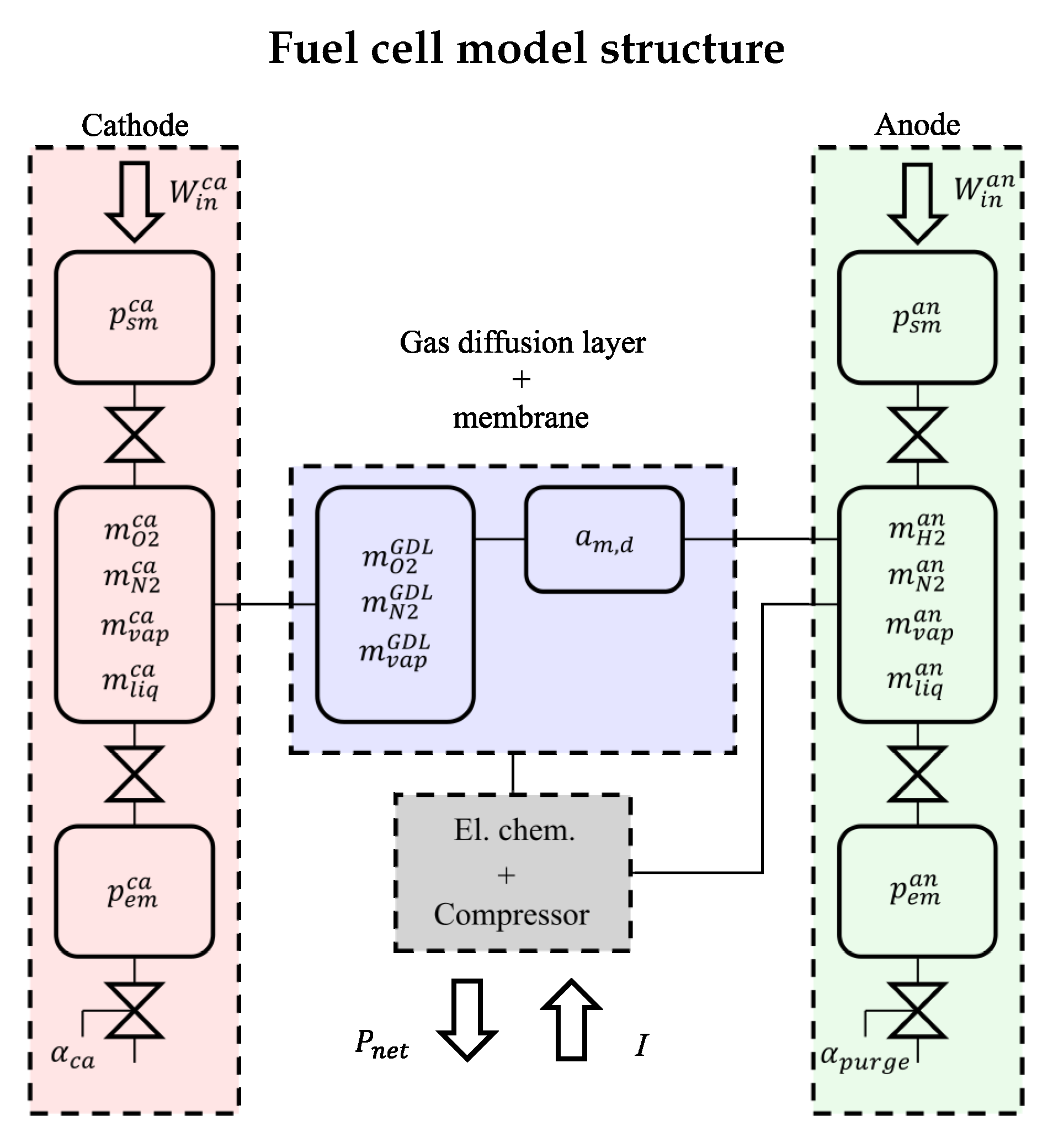
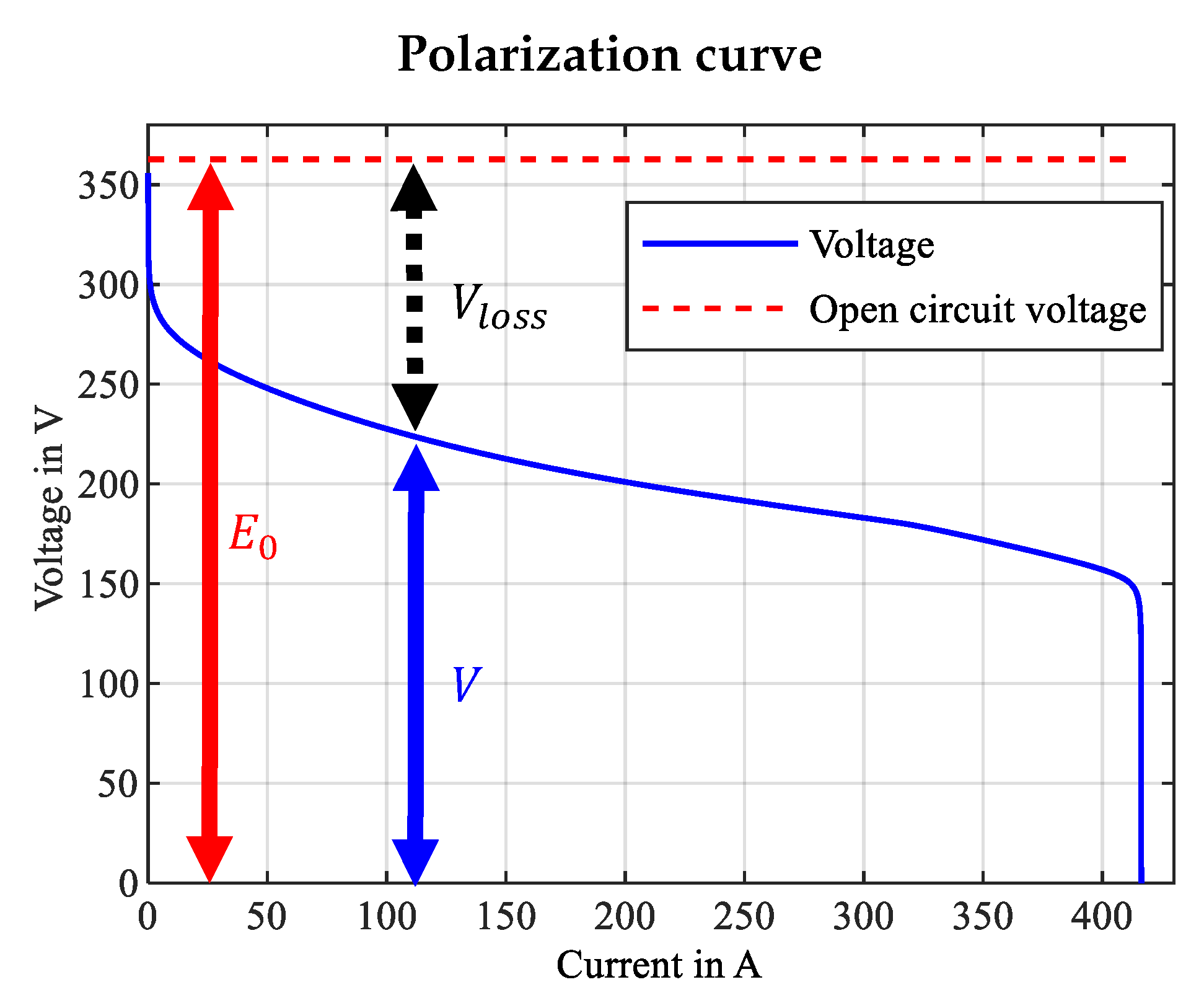
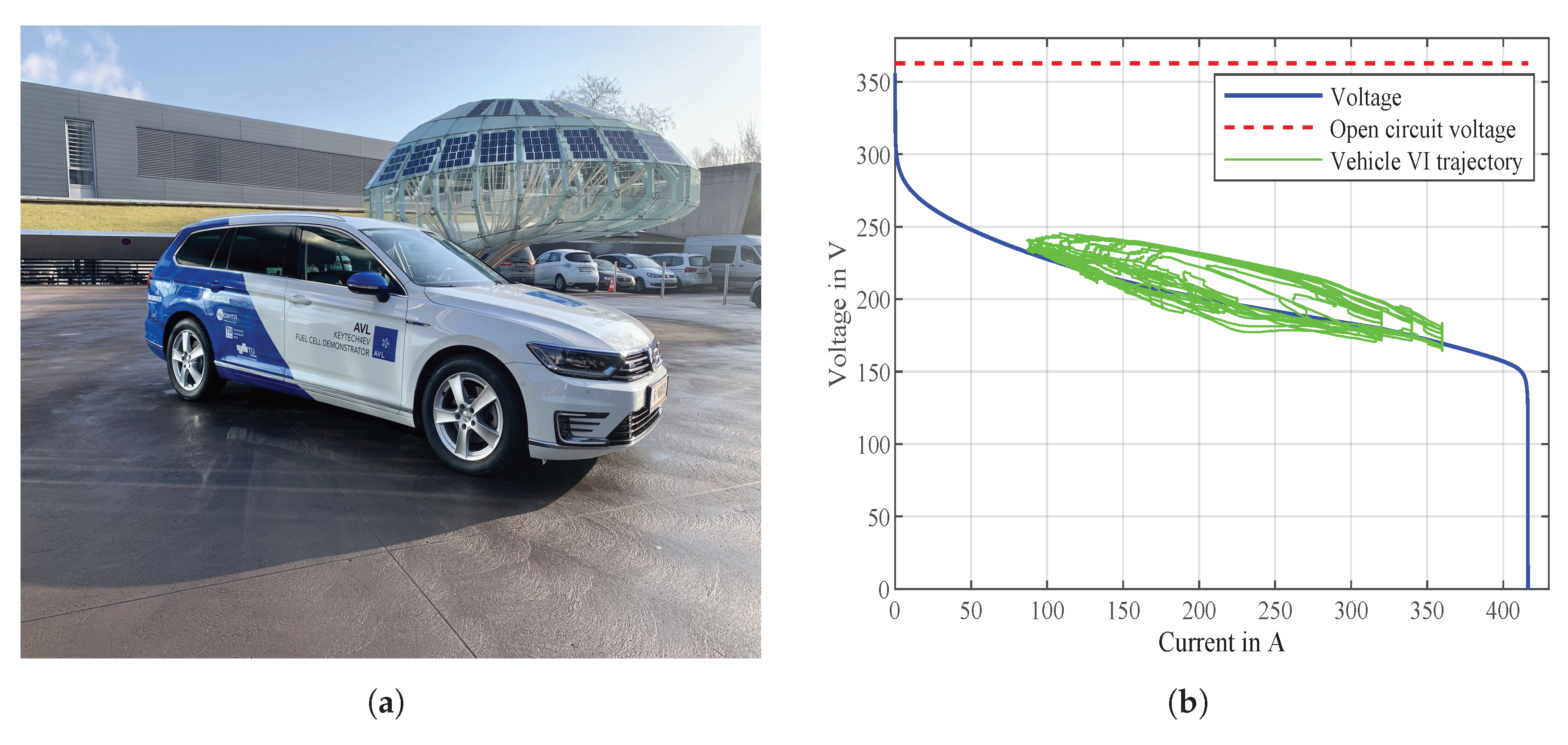
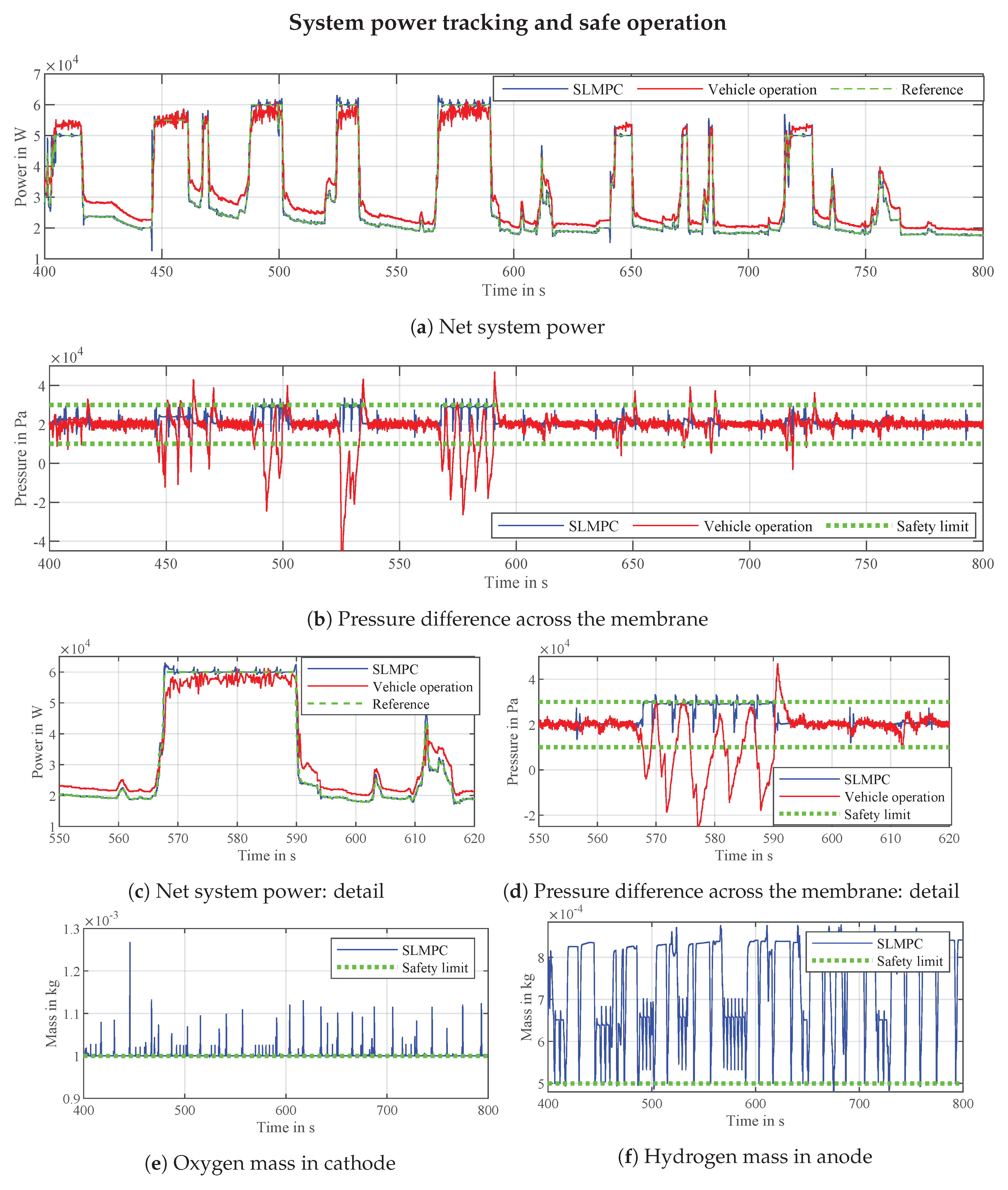
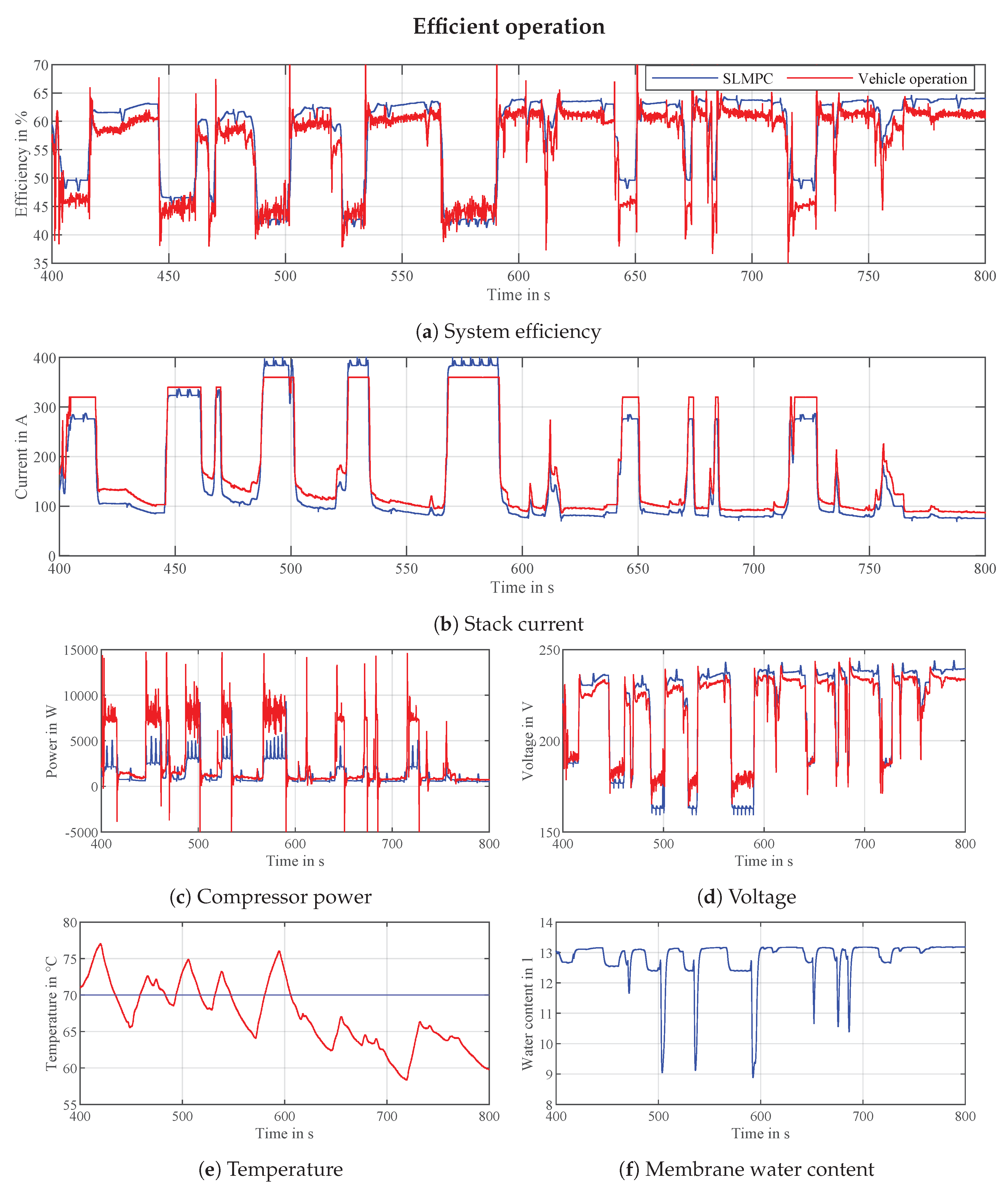
| Vehicle operation | 218.60 g |
| Simulation | 197.70 g |
Publisher’s Note: MDPI stays neutral with regard to jurisdictional claims in published maps and institutional affiliations. |
© 2020 by the authors. Licensee MDPI, Basel, Switzerland. This article is an open access article distributed under the terms and conditions of the Creative Commons Attribution (CC BY) license (http://creativecommons.org/licenses/by/4.0/).
Share and Cite
Vrlić, M.; Ritzberger, D.; Jakubek, S. Safe and Efficient Polymer Electrolyte Membrane Fuel Cell Control Using Successive Linearization Based Model Predictive Control Validated on Real Vehicle Data. Energies 2020, 13, 5353. https://doi.org/10.3390/en13205353
Vrlić M, Ritzberger D, Jakubek S. Safe and Efficient Polymer Electrolyte Membrane Fuel Cell Control Using Successive Linearization Based Model Predictive Control Validated on Real Vehicle Data. Energies. 2020; 13(20):5353. https://doi.org/10.3390/en13205353
Chicago/Turabian StyleVrlić, Martin, Daniel Ritzberger, and Stefan Jakubek. 2020. "Safe and Efficient Polymer Electrolyte Membrane Fuel Cell Control Using Successive Linearization Based Model Predictive Control Validated on Real Vehicle Data" Energies 13, no. 20: 5353. https://doi.org/10.3390/en13205353
APA StyleVrlić, M., Ritzberger, D., & Jakubek, S. (2020). Safe and Efficient Polymer Electrolyte Membrane Fuel Cell Control Using Successive Linearization Based Model Predictive Control Validated on Real Vehicle Data. Energies, 13(20), 5353. https://doi.org/10.3390/en13205353





